As awareness of indoor air pollution is increasing, so too is our use of air cleansing products such as air purifiers. At face value, this is fantastic – more people than ever are conscious of how poor air quality impacts their lives, and we are taking steps to safeguard the health of ourselves and our families.
However, while this is a positive change, it doesn’t come without issues of its own. The vast majority of air purifiers on the market rely on tried and trusted HEPA filters. While these filters are extremely efficient, they also generate waste. A lot of waste. With many air purifiers needing filter replacements every three, six, or twelve months, the environmental impact of HEPA-based air purifiers quickly adds up.
This has led to inventions such as ionising air purifiers that remove the need for HEPA filters. However, while this is one approach quickly gaining traction, there is another path. That is the path Briiv opted for.
Briiv is an air purifier that aims to use only natural materials. While the filters need to be replaced over time, using materials such as coconut, charcoal, silk, and moss ensures that most waste generated by the device is biodegradable.
This has made Briiv a unique product within the air purifier market. Not only is Briiv aiming to be environmentally friendly, but it’s also one of the most beautiful air purifiers on the market. This device exists in a niche where even saying the word beautiful feels weird – air purifiers are generally big, ugly plastic boxes!
However, Briiv has created an air purifier that I consider beautiful. Instead of trying to put the device somewhere unnoticeable and out of the way, I want this to be a feature piece on my desk. In these ways, Briiv has carved a niche of its own.
With these unique benefits, it’s time to see how Briiv performs and whether it’s worth the relatively hefty price. In this review, I aim to assess the Briiv after spending a couple of weeks with the device in different rooms around my house. I will also look at the science and ideas behind the device and how these translate into real-world usage.
If you’re considering purchasing a Briiv air purifier for yourself, I hope this review can answer any questions about the device you may have. While I have done my best to be as in-depth as possible in this article, there is a chance I’ve left something unanswered. Please feel free to comment on the post and let me know if this is the case. I’m more than happy to answer future questions! With that out of the way, let’s dive in!
Subscribe to BreatheSafeAir
Air pollution is a silent killer that affects millions of people worldwide. Start protecting yourself today.
This post contains affiliate links. For more information, please refer to my affiliate disclaimer. I was sent a product for review, but the article is not sponsored. All opinions expressed in this post are my honest thoughts. I only recommend products that I genuinely believe in.
Information on this blog is for informational purposes only. Readers are encouraged to confirm the information herein with other sources. Furthermore, this information is not intended to replace medical advice from professionals. This website assumes no responsibility for the accuracy of the information, and information is subject to change without notice. Devices mentioned on this website are not medical devices and do not guarantee protection.
The Environmental Issue
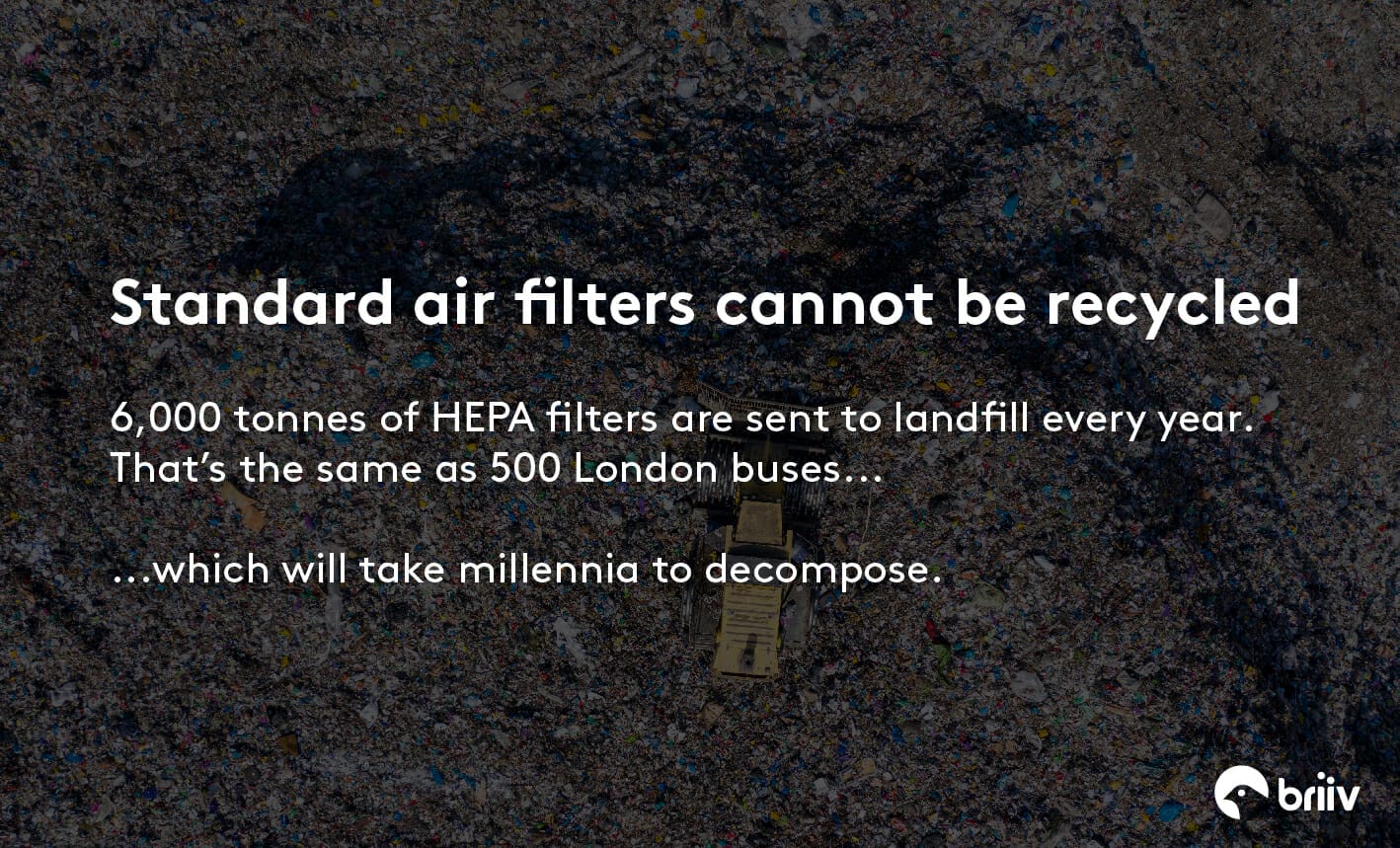
Source: Briiv
There is a certain irony in that most air purifiers are themselves very polluting devices. HEPA filters have finite lifespans and take thousands of years to decompose. Considering these filters need to be replaced every three, six or 12 months, the devices we use to remove one form of pollution contribute significantly to another.
According to Briiv, in 2019, 15,000,000 air filters were purchased. This comes out to around 6000 tons of HEPA filters annually – an unsustainable amount. On top of this, many HEPA filters being disposed of aren’t just filter media. Instead, they have plastic trays, metal frames, and other pieces attached to them. This only exacerbates the issue.
With air purifiers and filtration systems becoming more essential than ever due to the spread of COVID-19 and worsening air quality in many areas, it’s likely that the number of HEPA filters reaching the waste every year has significantly increased since 2019.
This is what makes change and innovation essential. We need air purifiers that don’t rely on disposable, non-biodegradable filters. There are two ways to solve this – to create an air purifier that uses reusable filters (as in the case of many ionising air purifiers) or to create a device that uses disposable but biodegradable filters.
Briiv opted for the second solution. While the device uses three different filters, two are fully biodegradable as they are made entirely of natural materials. This means these filters can be thrown into your garden when they reach the end of their lifespan!
The image below does a good job of visualising the filters and how they are biodegradable. As seen, the moss and coconut filters can both be disposed of in your compost! Considering these filters make up the bulk of the filtration system, Briiv significantly reduces waste compared to most air purifiers.
While 78% of the filter media may be natural, it’s important to remember that 78% is not compostable. The wood carbon is woven into the silk nano fibre filters, which are not compostable. This means that although the wood carbon may be naturally sourced, it still needs to be disposed of in the waste. Even considering this, Briiv is far more eco-friendly than any other air purifier I’ve found.
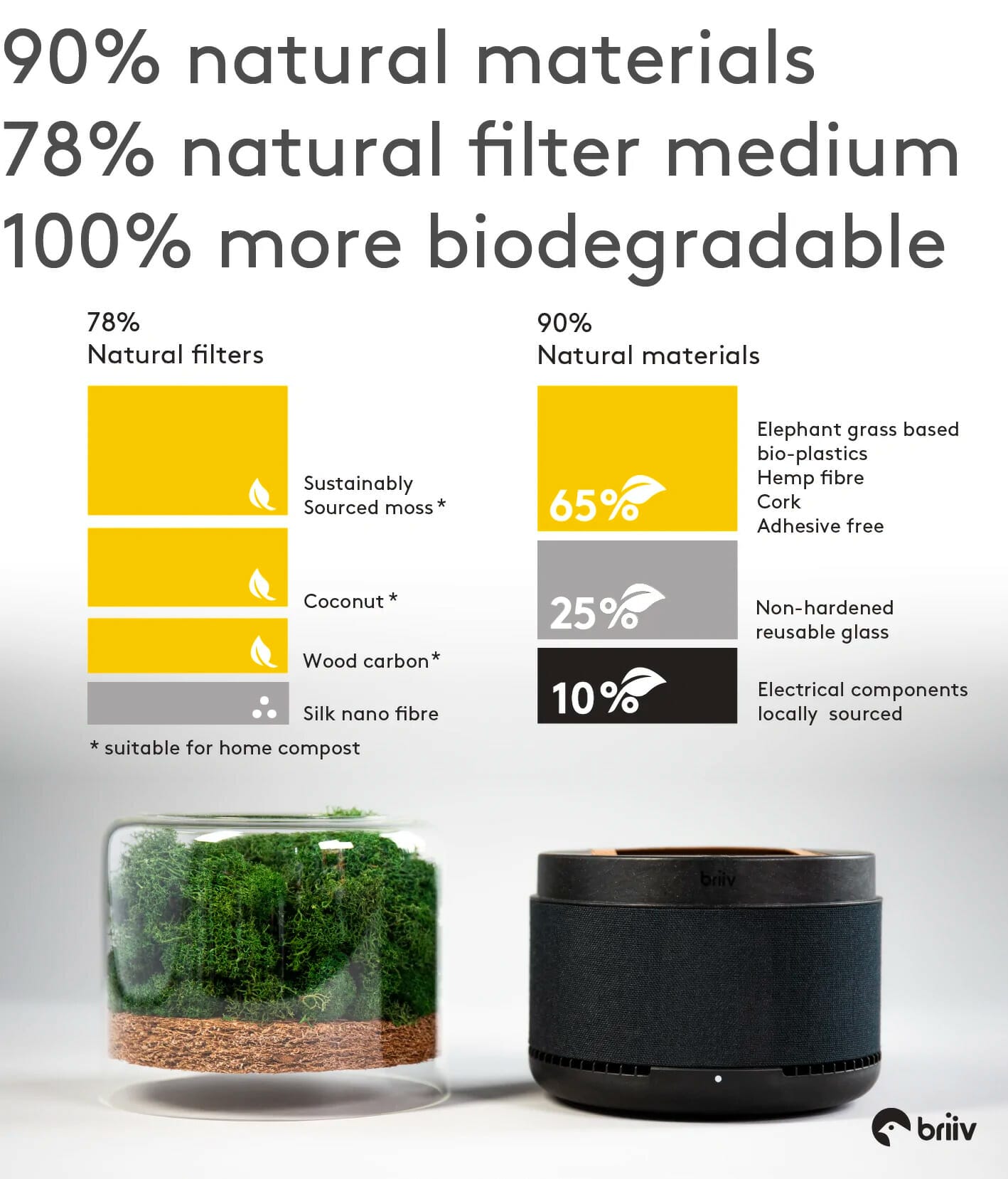
Of course, filters aren’t everything. At some point, your air purifier will stop working and need to be replaced. For many air purifiers on the market, this means disposing of a big mass of plastic, electronics, and metal.
Briiv isn’t perfect, as 10% of the device is electronic parts that must be disposed of separately. However, the other 90% of the device is made from biodegradable or recyclable materials. This means even at the end of the device’s lifespan, Briiv is a far greener solution than the alternatives.
Even the plastic on Briiv that is seemingly non-biodegradable is actually the contrary. Briiv opted to use bio-plastic based on elephant grass which is also biodegradable. This makes the device one of a kind.
Briiv still creates some waste. However, the waste created over the lifespan of this innovative air purifier pales in comparison to what other air purifiers produce – even the more environmentally-friendly ionising devices. I love to see innovations like this, and I am impressed by the thought Briiv has put into being eco-friendly.
Of course, being eco-friendly is useless if the device doesn’t perform adequately. With that in mind, let’s look at the most important aspect of this review. Does Briiv actually perform as an air purifier? Are the natural filters as effective as HEPA filters? Let’s take a look.
Are Air Purifiers Needed?

Household air pollution banner from WHO.
I commonly get asked this question about whether or not air purifiers are beneficial to indoor air quality. While it does depend on the air purifier in question, the general answer is yes. Air purifiers can be very beneficial, and an effective air purifier can bring various health benefits.
The two types of pollutants that air purifiers most commonly target are VOCs (volatile organic compounds) and particulate matter. Both of these pollutants can build up inside, and the indoor air you breathe is often dirtier than you might imagine.
The first type of pollutant that air purifiers are used against is VOCs. These are a range of gasses emitted from different sources around the home, many of which we don’t even realise. Some common VOCs are benzene, formaldehyde, and butanol.
Each of these impacts human health differently, but ideally, we want to minimise the concentrations of each of these chemicals as much as possible. VOCs are far more plentiful indoors than outdoors, with pollutants often two to five times more prevalent indoors than outdoors. Some pollutants can be found in concentrations as much as 100 times higher indoors!
The other common form of indoor air pollutants is particulate matter. You’re likely already familiar with two of these – PM2.5 and PM10. While these pollutants are often more of an issue regarding outdoor air pollution, they can also cause issues indoors.
Indoor particulate matter normally enters from outdoors or is generated through cooking or combustion. If you have a fireplace in your house, particulate matter can become a serious issue. If someone who smokes lives in your house, this is also a big cause of high concentrations of particulate matter indoors.
VOCs and particulate matter can cause short and long-term illnesses if not managed correctly. Although we can’t see and therefore often don’t consider them, these forms of indoor airborne pollution can greatly impact our lives and health. If we then consider how much time we spend indoors (for some people, it’s as high as 90% of our time!), an issue quickly becomes obvious.
This dispels many people’s belief that indoor air quality is less of an issue than outdoor air quality. Actually, in many countries with cleaner air, it’s the opposite. To decrease concentrations of these potentially dangerous pollutants, good ventilation should be ensured, and air purifiers are worth considering.
It is important to note that ventilation is the best way to decrease concentrations of these potentially harmful pollutants. Provided the air outside is clean, there is no better way to increase the air quality inside than to ensure adequate ventilation. This means opening windows and doors when possible and allowing air to flow through your house.
With that being said, air purifiers are still useful. In South Korea, the air quality outside is often terrible. During these days, opening the windows is simply not a good option, and doing so would only allow more poor-quality air inside. On these days, an air purifier is the next best option.
Secondly, throughout winter and on days of bad weather, you likely won’t want to open your house up to the cold weather outside. The same goes for the hottest days of summer. During these times, an air purifier is a great option as it provides clear air without the downsides of bringing very warm or cold air inside.
Briiv Performance
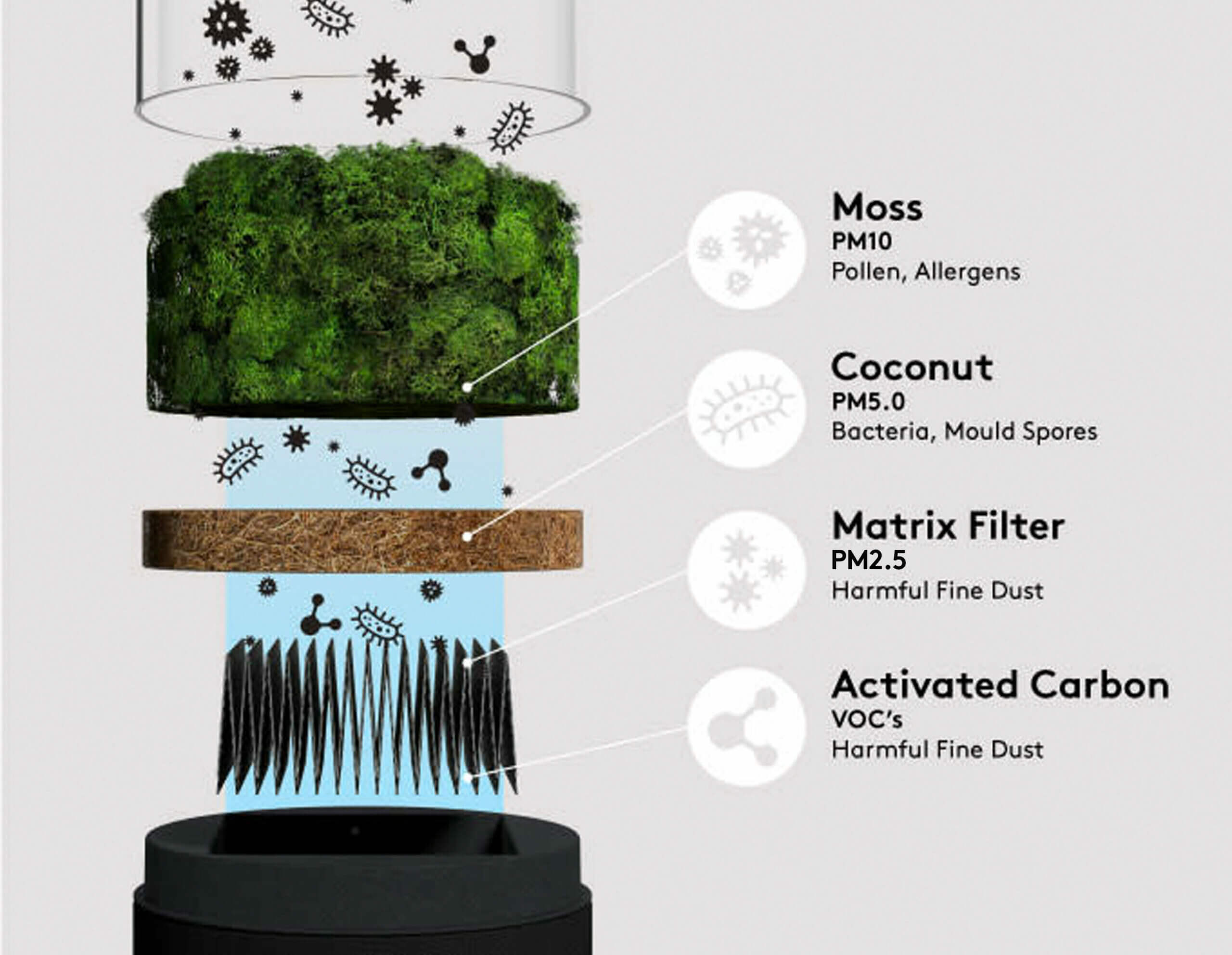
Briiv uses a multi-stage natural filter system that allows the filtration of both particulate matter and VOCs. Between these two, the vast majority of indoor air pollutants are captured, including many of the most harmful indoor air pollutants.
While the moss and coconut pre-filters remove many larger particles from the air, the silk filter does much of the heavy lifting at the end. This filter can remove ultrafine particles, and an activated carbon layer is added to filter volatile organic compounds that pass through the device.
To test the filtration efficacy of the individual filter layers and the device overall, the team at Briiv has run a range of tests on the device. These can be viewed on the performance page of its website, which can be found here.
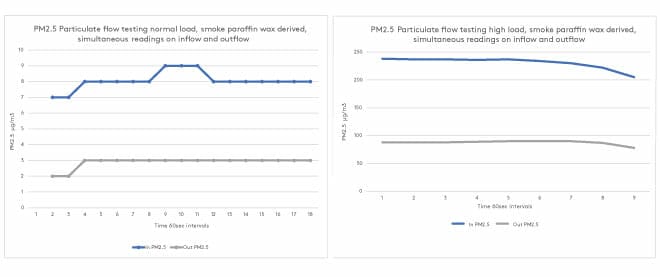
The tests above show a normal load of PM2.5 and an exceptionally high load of PM2.5 being filtered by Briiv. The upper blue line represents particles entering the device, whereas the lower grey line represents particles exiting the device. These images show that about 65% of the PM2.5 is being filtered in the first graph with the second graph mirroring these results.
65% filtration might not seem exceptionally high, but it’s important to remember this is on a single pass. Air will often circulate through the purifier multiple times, and the particles are partially filtered each time. Over time, this can greatly reduce the particulate pollution in the air.
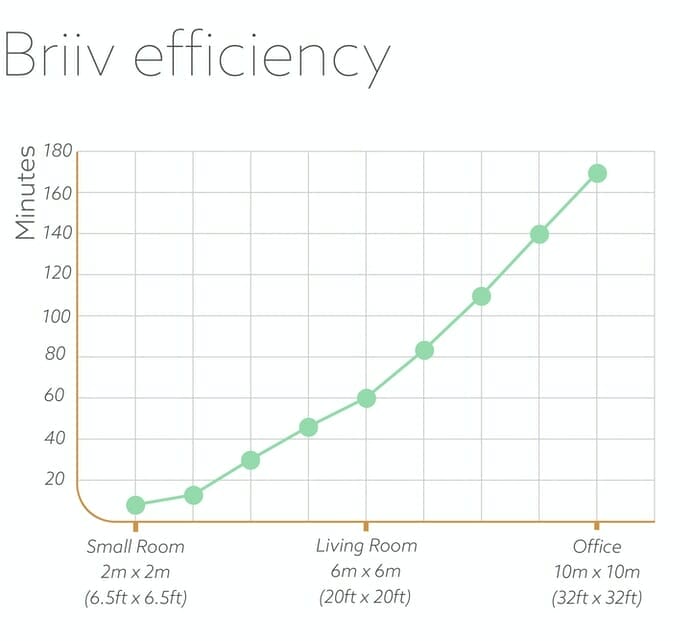
The main limitation of Briiv regarding filtration is the relatively low airflow of the device. For its size and power draw, Briiv performs very well, circulating a 36m² (387ft²) room in around an hour. However, many larger devices could circulate the same room multiple times in the same length of time.
The graph above shows the times Briiv should take to circulate the air in a range of rooms. It’s worth noting that these findings are probably found using the device’s highest fan speed – a fan speed that I wouldn’t recommend using unless you are outside the room.
While this is a downside to Briiv, I don’t consider it a deal breaker. The device is not meant for big rooms, and nowhere is it suggested that it should be used in these environments. Instead, Briiv is ideal for bedrooms, home offices, small living rooms and lounges.
Test Results
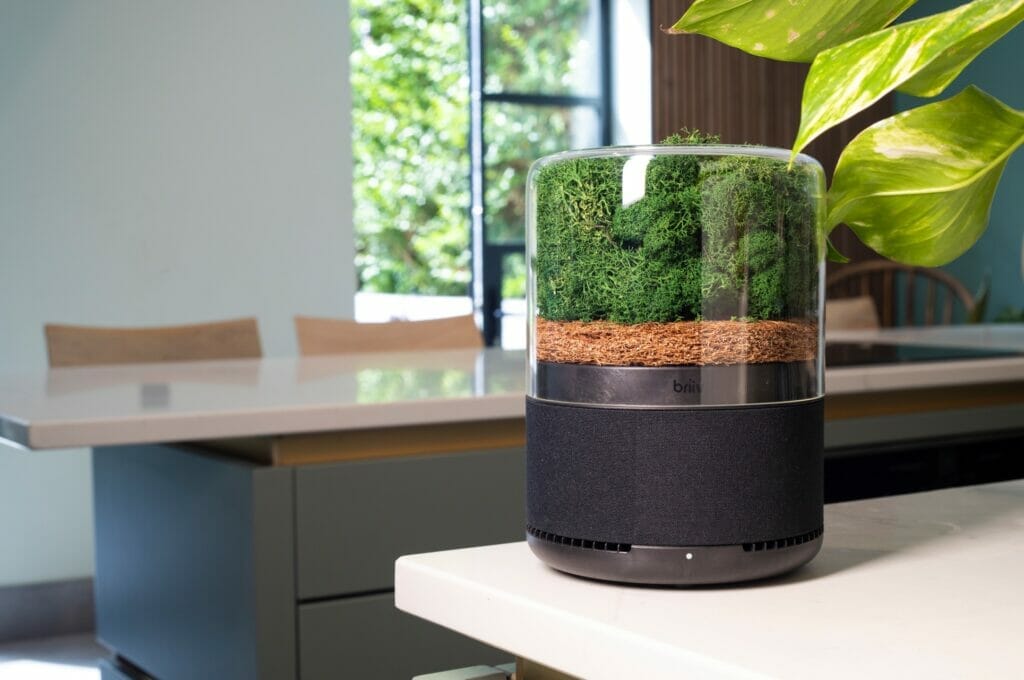
It’s always hard to monitor air purifiers’ performance without specialised (and very pricey) equipment. Many devices on the market simply don’t perform, making many people wary of air purifiers, with some going as far as calling them a scam.
While I don’t have access to highly accurate equipment, I do have consumer-level air quality monitoring equipment on hand. When I reviewed the Sqair air purifier, I used my uHoo air quality monitor to asses if the device worked. From that review, I discovered that the device made quite a difference, and I’ve believed in air purifiers ever since.
Although I don’t have my uHoo with me right now (that would be my ideal monitoring device), I do have my Atmotube Pro. For this section, I will use that to monitor particulate and VOC levels. This device is not hyper-accurate, but I found it to be great for providing insight into local air quality conditions through my own review.
Both PM1.0 and PM2.5 readings on this device are quite accurate, as found by the South Coast Air Quality Management District and VOC readings are also accurate within 15%. This makes it a good choice to monitor the difference Briiv makes on indoor air quality.
So, what about when it comes to my own findings regarding the air quality changes with Briiv? Well, below are my results when monitoring the air quality with my Atmotube Pro. I’ve included two sets of results, with the first showing my normal room air quality (which is normally quite good). The second set of results shows the impact of Briiv in a polluted room where I lit a candle. While rooms should never get this polluted, it was the best way I could think of to exemplify the abilities of the air purifier.
Clean Room
Below are images showing the air quality score in my bedroom. In this case, the higher the score, the better, with a blue bar representing a score of 80+ and green being 60-80. I turned Briiv on level 3 at around 9:25, and you can see that while the air purifier made no difference instantly. However, over 20 minutes, the air quality increased to an average of 86 (from a previous 78). After keeping the device on level 3 until 10 am (around thirty minutes), the air quality score reached 91 and didn’t increase past that point.
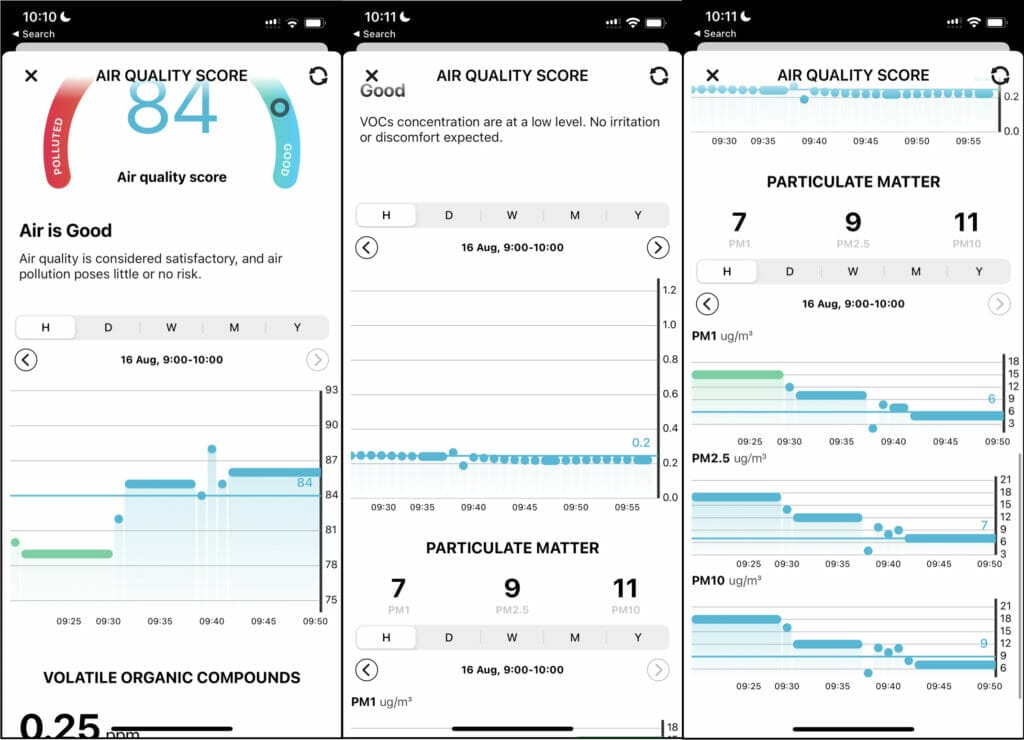
From left: Air Quality Score (higher is better), VOCs, particulate matter (PM1, PM2.5 & PM10) over 30 minutes with Briiv on.
I then lowered the fan speed to level 1, and the air quality score hovered between 88 and 91 until noon. This was a marked improvement over previous ambient levels for a room that normally sits between an air quality score of 70-78 when the windows are closed. Interestingly, Briiv struggled to get past a reading of 91. While air quality did improve to 92 at times, this was only temporary. Luckily, 91 and 92 show good air quality that I wouldn’t complain about!
During this testing, the Atmotube Pro was set about five metres away from Briiv. I also ensured that all windows and doors in the room were closed for the duration of my testing. This testing shows that in a small room (I used it in my bedroom), Briiv can make an impact on air quality. While I could have enabled level four on the device for better air quality, I prefer to use level 3 as it has a lower pitch (and less annoying) fan sound.
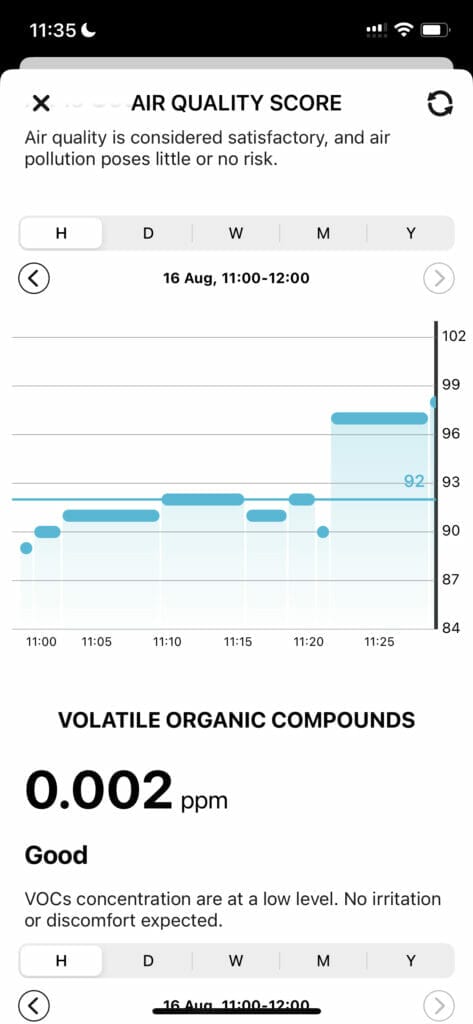
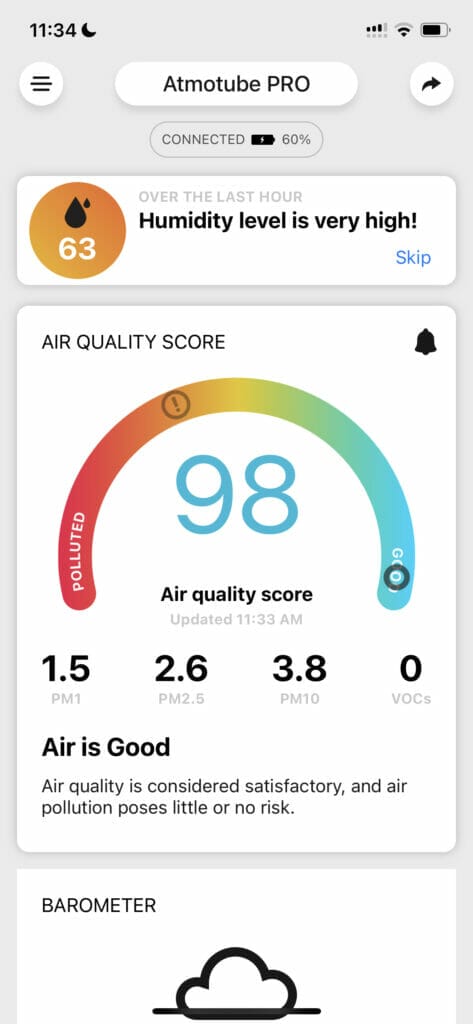
From left: AQS (higher is better) with Briiv at level 1. Highest Air Quality Score.
Diving into the individual pollutant concentrations over this period, we can see that Briiv significantly reduced PM1, PM2.5 and PM10. For all these particulate pollutants, concentrations dropped from 15-18μg/m³ to a consistent 3-5μg/m³. Again, this is a marked improvement, and this low level of particulate pollution was maintained after leaving the device at level 1 for many hours (after an initial 30-minute cleaning at level 3).
VOCs also dropped while Briiv was on, but the difference here was less pronounced than the difference seen with particulate matter. At 9:25 (when Briiv was turned on), VOC levels consistently sat at 0.25 – 0.3 ppm. By 10 am, levels had dropped to 0.22ppm. Interestingly, by 11 am, these levels had dropped even further to 0.13 – 0.16ppm. While these levels were far from bad initially, it’s good to see Briiv positively impacting VOCs and particulate pollution.
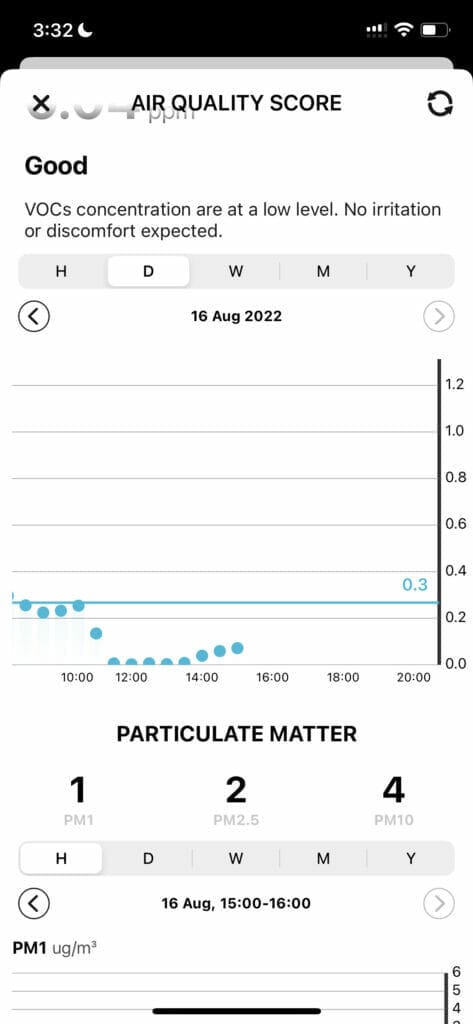
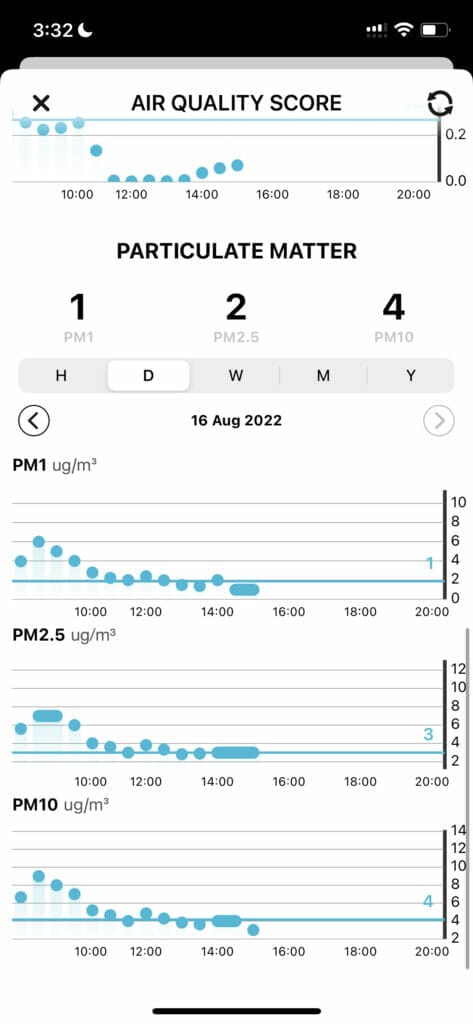
From left: VOC readings from 9 am to 3 pm. Particulate matter readings over the same period. Lower is better for both.
For this testing, I used the device on level 3 for half an hour before turning the air purifier to level 1. However, the device has four fan speed levels, and I would be remiss if I didn’t test the top level too. While I would never use this speed while I am in the room, it can be good for cleaning out a room while you’re out or doing something elsewhere in the house.
At 11 am, I turned Briiv on level 4 and let it go for thirty minutes. The results over this period were both the most impressive and most intriguing. According to Atmo, my overall AQS increased to a fantastic 97 (with occasional drops to 96 and increases to 98). VOCs dropped to negligible levels under 0.01ppm, and PM1, PM2.5 and PM10 all sat under 3μg/m³. PM1 and PM2.5 were usually significantly better, sitting at around 1.5μg/m³ and 2μg/m³, respectively.
Given more time to clean the air, I could see Briiv working in a significantly larger room. If you have a moderate-sized living room or lounge, Briiv would make a great addition in those areas. Due to its relatively small form factor and beautiful design, it suits many locations around the house.
Highly Polluted Environment
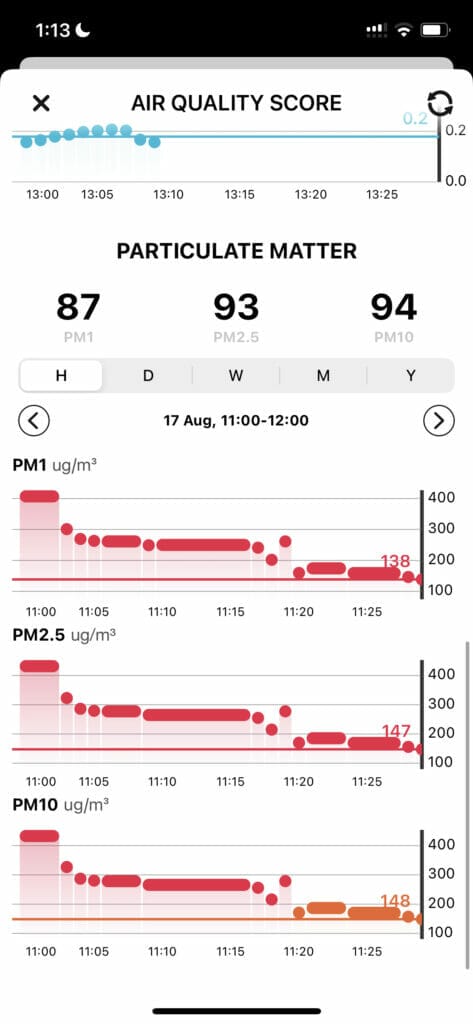
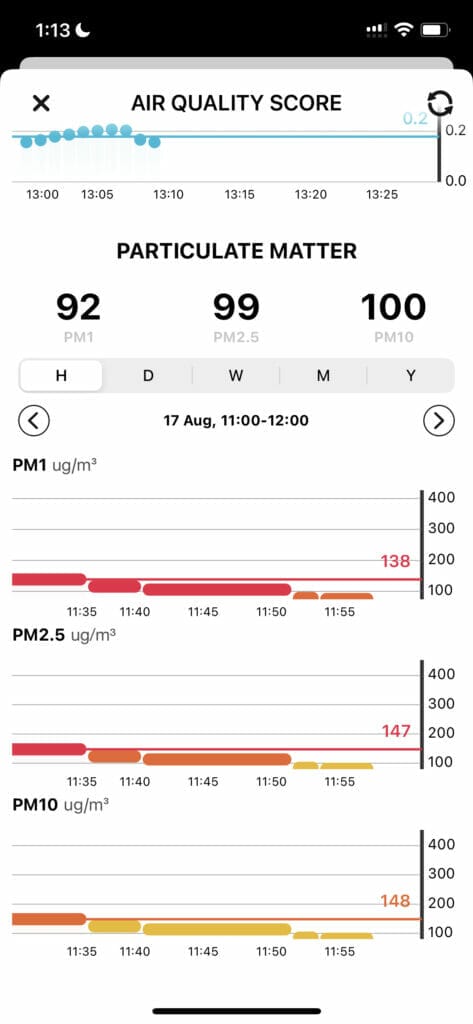
From left: 11am – 11:25 am particulate matter levels. 11:30 – noon particulate levels.
Although not a particularly realistic situation, there are times when you’ll want to clean the air in a far more polluted environment. Where the first situation is more realistic, this example is more representative of the capabilities of Briiv – even if they aren’t usually used.
In this situation, I lit multiple candles in my bedroom. I let the candles burn for 20-minutes (10:40 – 11 am) and then removed them from the room. The candle smoke emitted a range of particulate matter, and PM1, PM2.5 and PM10 readings all reached 400μg/m³ or more.
My air pollution monitor was seated in the same position as the previous example – about 5 metres away from Briiv (on the opposite corner of the room). I then set Briiv to level 4 – the highest speed – and vacated the room for an hour. All windows and doors were closed during this time, and there was no ventilation in the room.
Over an hour, Briiv was able to reduce particulate pollution levels from 400μg/m³ to 100μg/m³ or less (in the case of PM1 and PM2.5). While this result impressed me, it’s no use without a point of comparison. Therefore, I repeated the same experiment and instead turned off Briiv. Over an hour, levels beginning at 350μg/m³ decreased to just over 280μg/m³.
These results show that briiv at level 4 can clean even very polluted rooms. However, you do need to give the device some time – for the air quality to reach a reasonable level, I would have given the device another 30-minutes to clean before entering the room again.
Although far from scientific, these results show that Briiv can circulate and clean the air in a medium-sized room. It will need some time to cycle the air entirely, and I recommend keeping the device on level 3 or 4 while initially cycling air. However, once the air has been initially cycled, Briiv can be turned down to level 1 or 2 to maintain the air quality.
Design
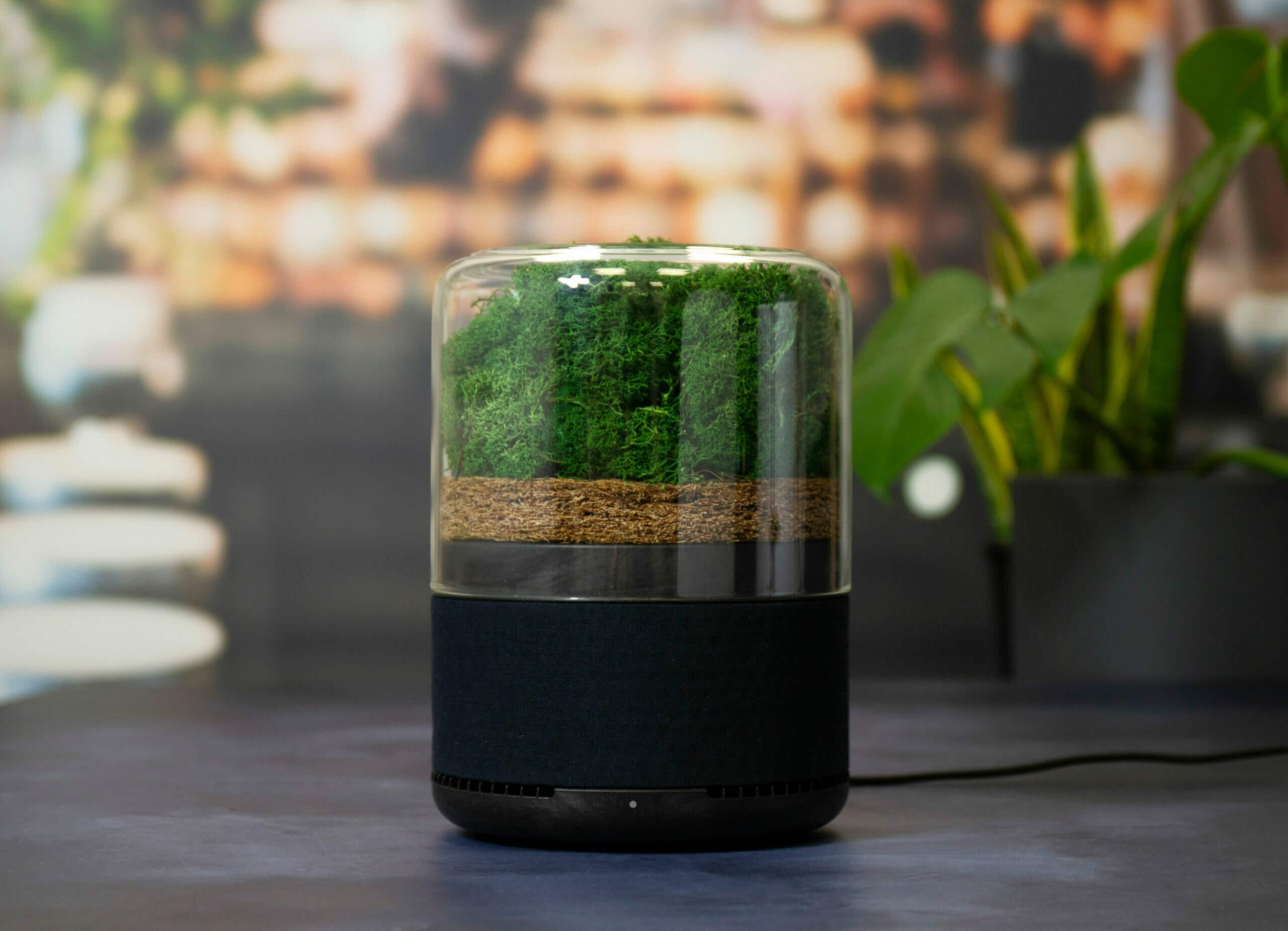
The design of Briiv is a definite strength of the product. It’s a beautiful device and one that is eye-catching wherever you decide to place it. It’s modern and minimal, allowing it to fit nicely into any house or apartment.
At this point, it’s abundantly clear that I love the device aesthetically. The glass dome and black colouring give the device a contemporary feel that feels sleek and elegant. Although the bottom of the device is plastic, the plastic looks high-quality, and it could be mistaken for metal at a glance.
Of course, the main stars of the show when it comes to aesthetics are the filters. In most air purifiers, manufacturers try to hide the filters and for good reason, as they are often ugly and unsightly. Briiv is the complete opposite – the filters are visually appealing and give the whole device a natural feel.
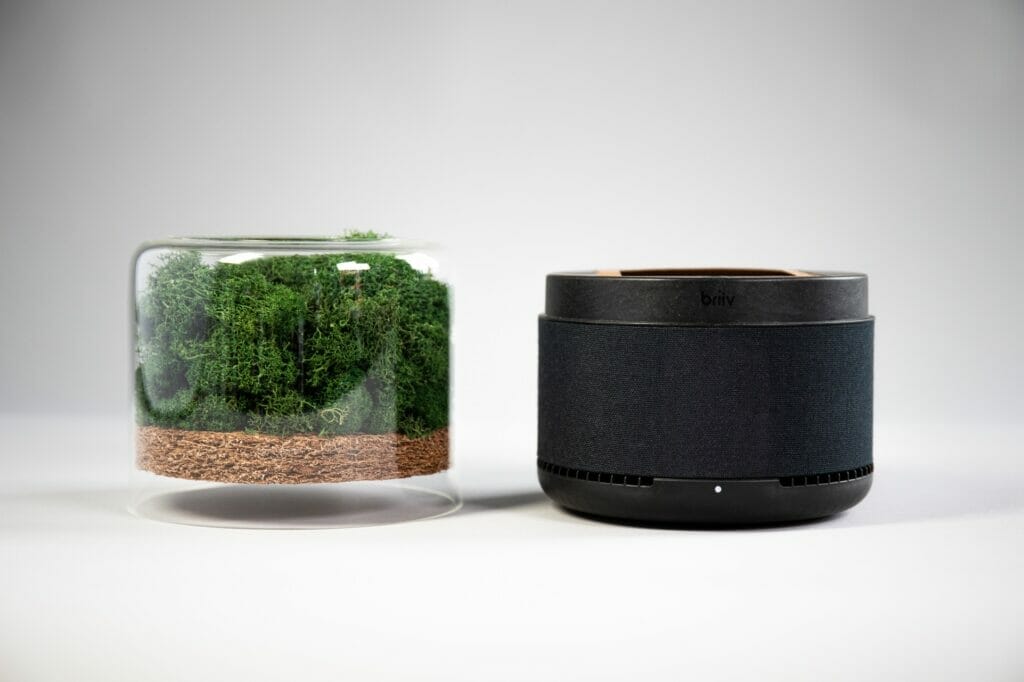
Although the device has a range of colours when fully equipped, they all remain somewhat muted and don’t overly stand out. This means the device can sit in a range of different locations. Personally, I sit my Briiv air purifier on my desk, and even though the colours don’t match in the slightest, I feel like Briiv adds to the appeal of my working area.
Functionally, Briiv also does exceptionally well. The filters in the device are very easy to replace, and I never had any difficulty dissembling the product, changing filters, or moving it from room to room. My biggest difficulty was keeping smears off the glass dome, which was a self-created issue due to my pedantic nature.
The choice to power the device by USB was a smart one. USB wall adapters are plentiful in any home and come in many shapes and sizes. This allows users to match the power socket to their needs. Trying to run the cable behind a bookshelf? Use a low-profile USB adapter. Trying to run multiple things from USB? Use a USB power hub!
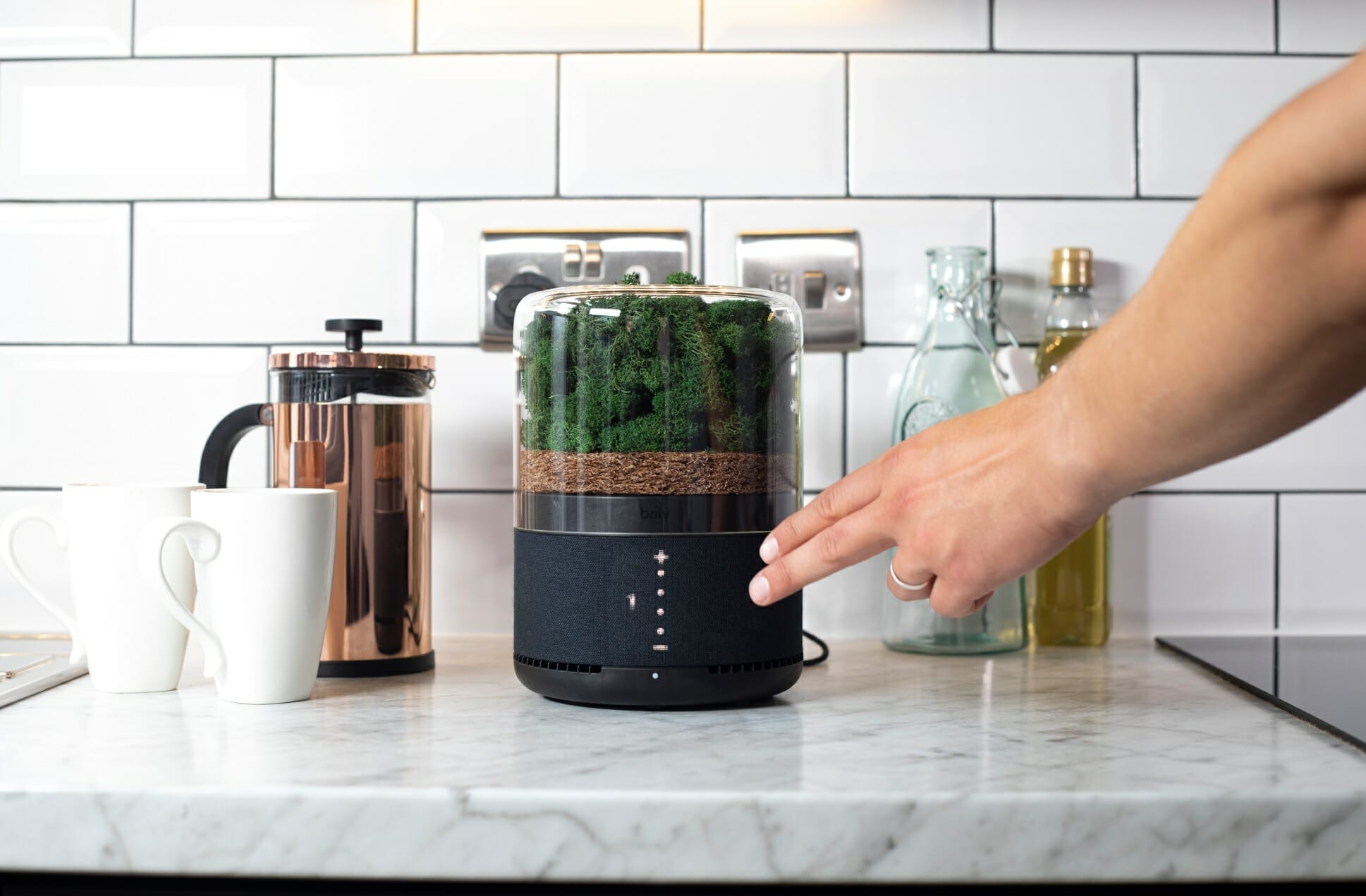
Functionally, the Briiv excels in all but one area. This is the touch-sensitive front panel. The main control panel for the device is a very simple menu with power levels that can be tapped to either increase or decrease the fan speed. The button lights are generally disabled but illuminate when motion is detected in front of the device.
This panel was perfectly usable, and I never had any issues with actually using it. However, it felt a bit cheap for a product this expensive. Of course, many people will not even use the touch panel, preferring instead to control the device via the app. In my case, I preferred to use the front panel simply due to my proximity to the device while working.
The lights on the panel are also hard to distinguish off-centre. I sit with the device to my right, meaning I am almost always looking at the panel from the left. At this angle, it’s quite challenging to tell which fan speed the device is currently set. From straight-on, this isn’t an issue.
Physically, I only had one issue with Briiv: the feeling of the materials on the base, specifically the mesh surrounding the bottom of the device. Although I know this material is eco-friendly and far from cheap, it feels a bit cheap. Again, far from a deal-breaker, but I would love to see improvements in this area.
Overall, Briiv does a fantastic job when it comes to design. I am aware of other plant-based air purifiers on the market, but even among these, none look quite as good as Briiv. You can tell that a lot of effort has gone into designing this product and ensuring it looks as aesthetically pleasing as possible.
App & Integration

Briiv’s app is okay as it’s neither great nor bad. It does everything it should, and I never had any issues with it. However, it also doesn’t feel particularly great to use and looks unpolished (on an iPhone 12). This stands in stark contrast with the device, which is designed fantastically.
My biggest issue with the app is the requirement to create an account and log in. When I just want to adjust the fan speeds on my air purifier, I don’t want to log in every time. While there is a ‘remember me’ button, I found that even with this enabled, I had to log in every few days when using the device.
Although many air purifiers require the user to make an account and log in, I am not a fan of this requirement. I don’t know the security implications, but I wish there were no need to log in simply to change the fan speeds on an air purifier.
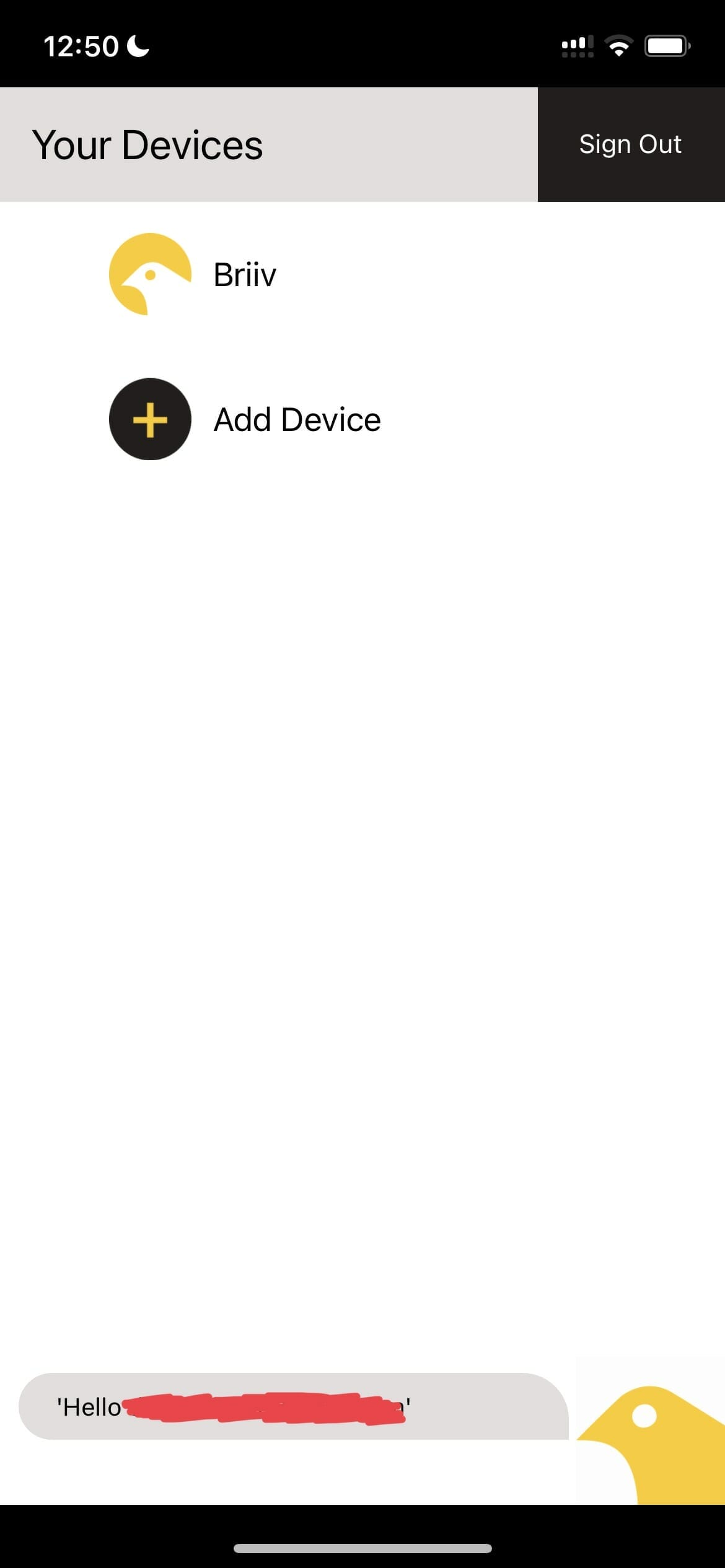

From left: control centre screen, home screen for an individual device.
Anyway, once you’re logged in, you can add your device in what was a painless process (far better than I have experienced with some other air purifiers). If you have purchased multiple Briiv air purifiers for different rooms, you can also add these all to the one central control area within the app.
Selecting the Briiv you want to control will bring you to a screen where you can adjust the fan speed on Briiv, set an operating schedule, boost the device for one hour, and check the lifespans of the filters. I tried all these functions and found them to work without issue – the app is very functional, and I’ve never had it crash or otherwise hinder my usage of the device.
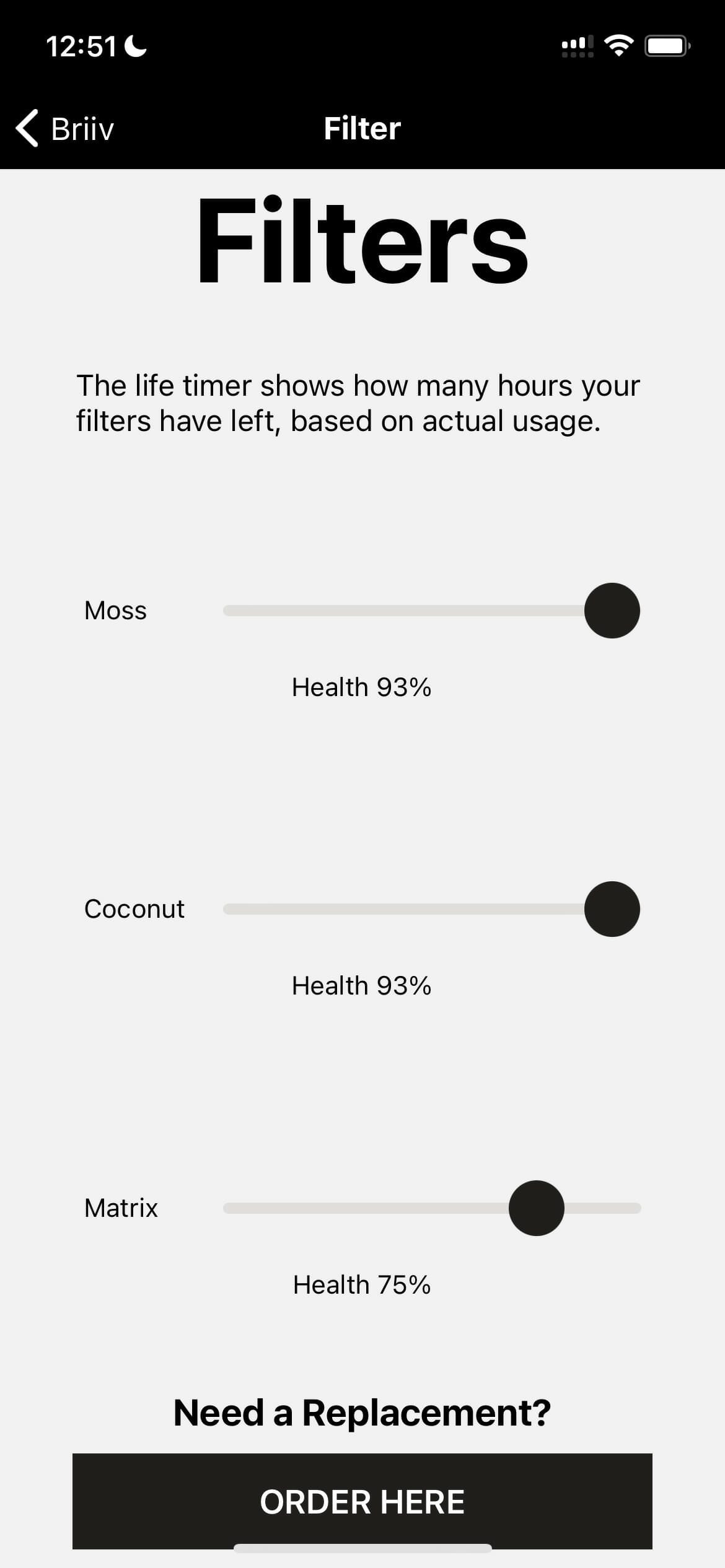
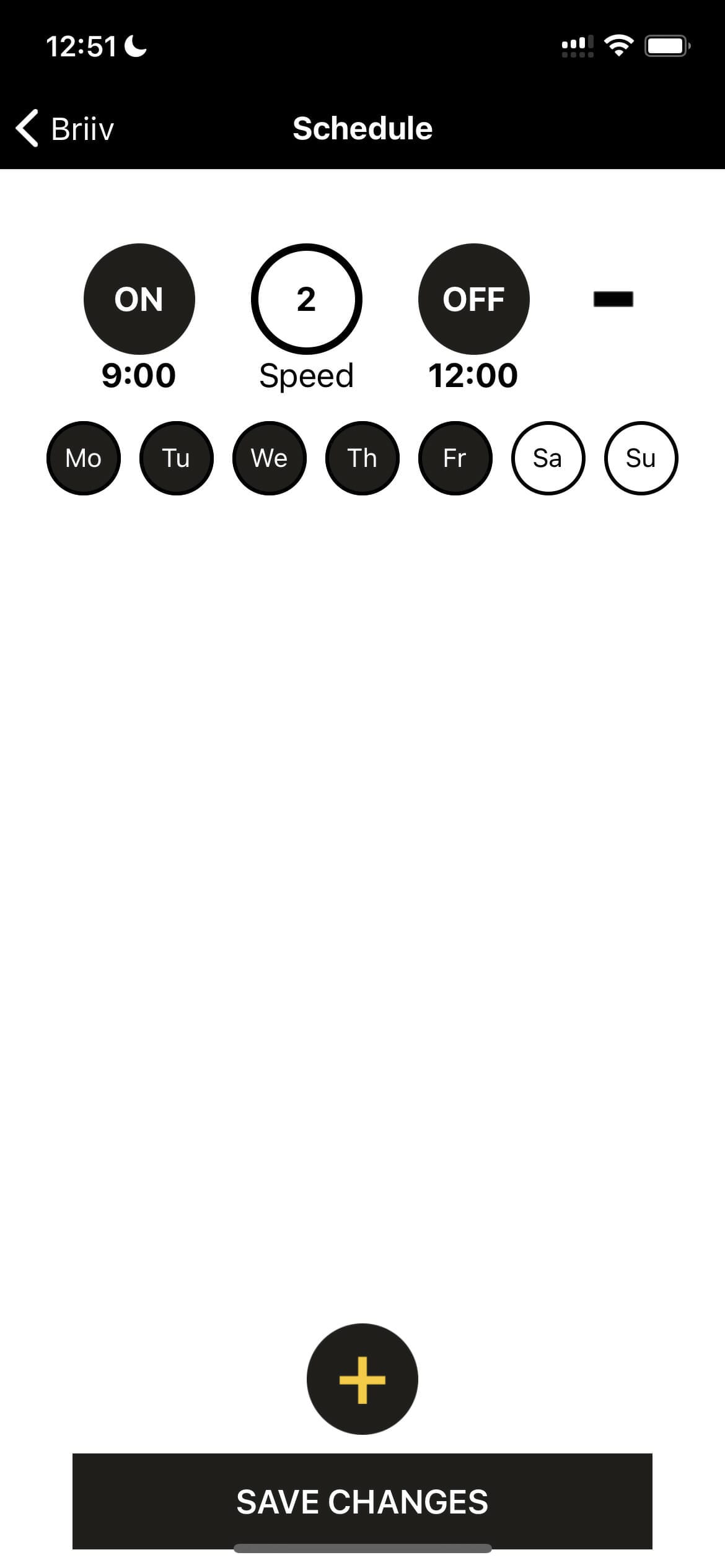
From left: filter health screen, schedule screen.
For me, the app’s most useful feature was seeing the lifespan of the different filters. With a relatively complex filter system, remembering when each filter was changed and when each is due to be changed would be a nightmare. Thankfully, the app makes it exceptionally easy to identify when changes are needed.
Overall, the app is excellent functionally. It allows users to change settings and view the information they need. However, it’s also an app that feels unpolished from a design standpoint. I would love to see improvements made in this area as most individuals primarily interact with their devices from the app.
Finally, I would be remiss not to mention Briiv has both Alexa and Google Assistant support for full integration into a smart home. I didn’t test either of these assistants as I currently use Apple Home, but they are present if you would like to enable them.
Price & Lifespan
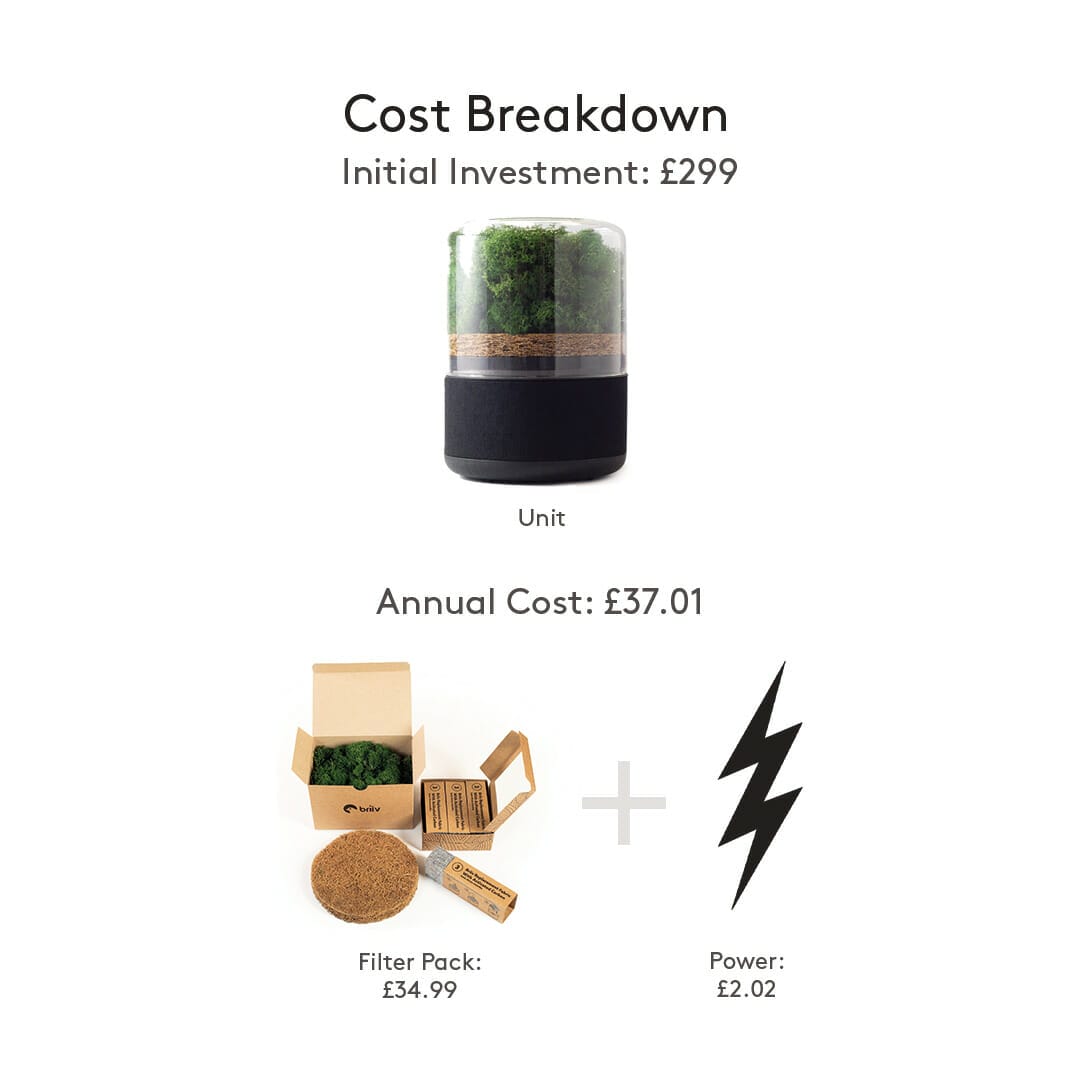
Briiv is not a cheap device, costing £299.00 as of the time of writing. With current exchange rates, this is around 360 USD or €355. If I had to point out the biggest downside of Briiv it would be the price. This is far from a cheap device; instead, it’s aimed at the more premium end of the market.
There are a few angles to approach this pricing from, and everyone will have a different view on whether this price is worth it. If you’re looking for the best-performing air purifier in this price range, Briiv is not it. There are air purifiers with greater flow rates capable of filtering more efficiently for significantly less. If you need an air purifier for a large room or are looking only for performance, you’ll want to look elsewhere.
On the other hand, Briiv might just be the device for anyone looking for a capable, eco-friendly, and exquisite air purifier. You’re not paying entirely for performance with Briiv. Instead, you are paying for a modern, minimal air purifier that looks like nothing else on the market. Of course, the device also offers capable filtration for a small or medium-sized room!
However, another factor needing to be considered is the long-term cost of Briiv. While I haven’t had the device for long enough to test this myself, the team behind the product is confident that Briiv comes out cheaper than many competitors in the long run.
Yearly, Briiv filters will cost £35. Briiv conveniently includes this all in a ‘one-year filter set’ that contains one moss pre-filter, one large particulate coconut filter, and four silk matrix filters. This pack will last users a year and ensure the filters are up to date and filtering.
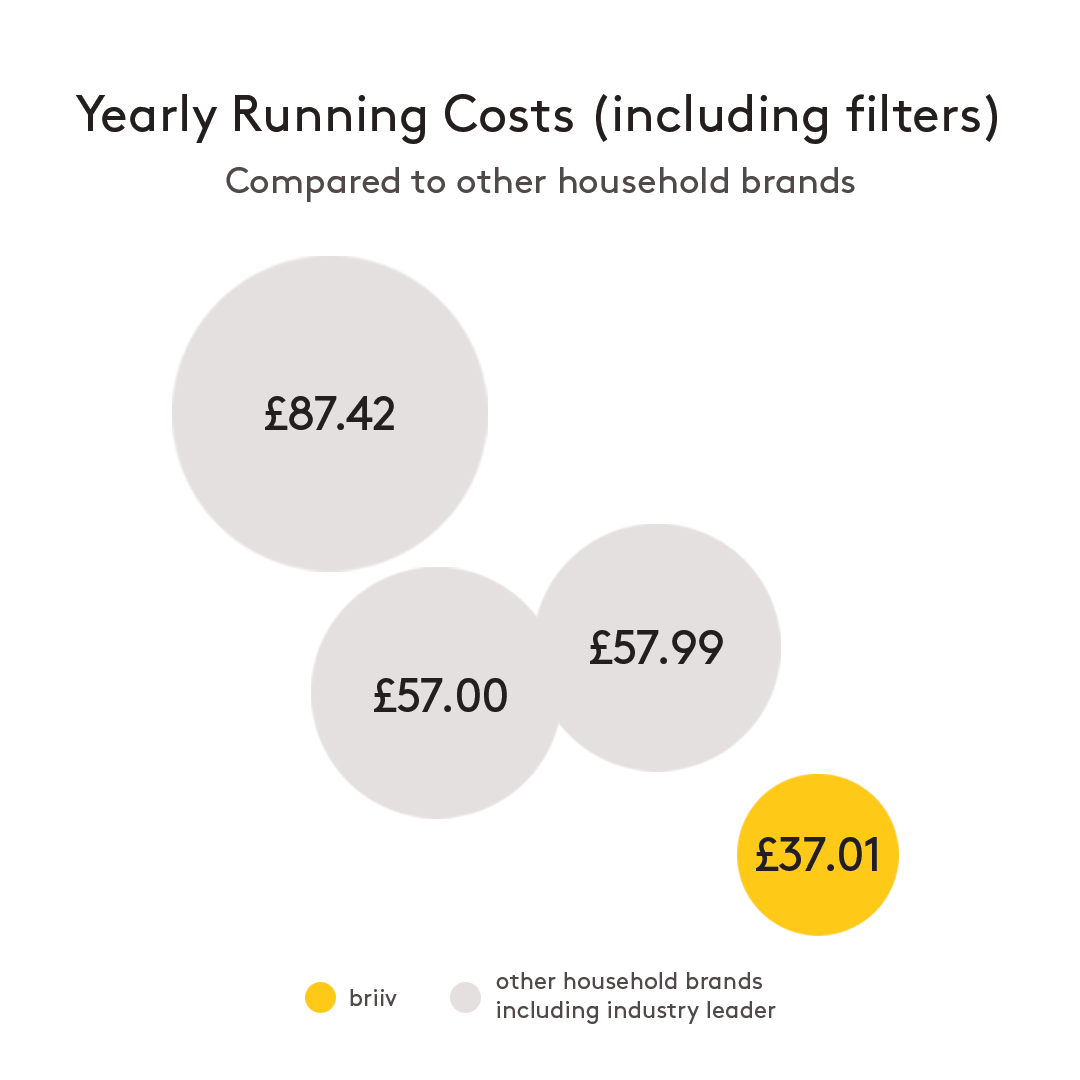
While these prices may seem steep, they are fairly reasonable for air purifiers. I reviewed the Sqair back in 2020, and this air purifier is claimed to be the most cost-effective air purifier in the world. However, even on that device, filters go for around $30, and carbon filters are an additional $20. These prices come out being very comparable to Briiv.
Another factor that needs to be considered is the cost of electricity. With Briiv’s environmental emphasis, making an exceedingly power-efficient device was also a big focus. Briiv is so efficient that it can even be powered from a 5v USB port – quite an achievement for any air purifier!
Based on energy costs in the UK, Briiv estimates the cost of running the air purifier every day for 6 hours to come out to £2 annually. While this price will change based on your location and local rates, it is undeniable that this is a power-efficient device that will be cheaper than the competition.
Therefore, Briiv is likely to come out cheaper in the long run. While the initial investment required is significant, the cheap running costs make the device far more appealing – while there is a premium upfront, this quickly balances out.
Overall, Briiv pricing may seem steep and is not within everyone’s budget. That said, I don’t believe Briiv isn’t over-priced, providing you consider the lifespan of the device rather than the upfront cost. With that in mind, there are cheaper devices on the market – many of which will cycle air faster and with similar filtration efficacy to Briiv.
With Briiv, you are paying a higher price for an eco-friendly, well-designed product that is not an eye-sore but rather an eye-catcher. As my testing has shown, Briiv is capable as an air purifier. However, at the same time, you’re paying for more than just a typical air purifier.
Conclusion
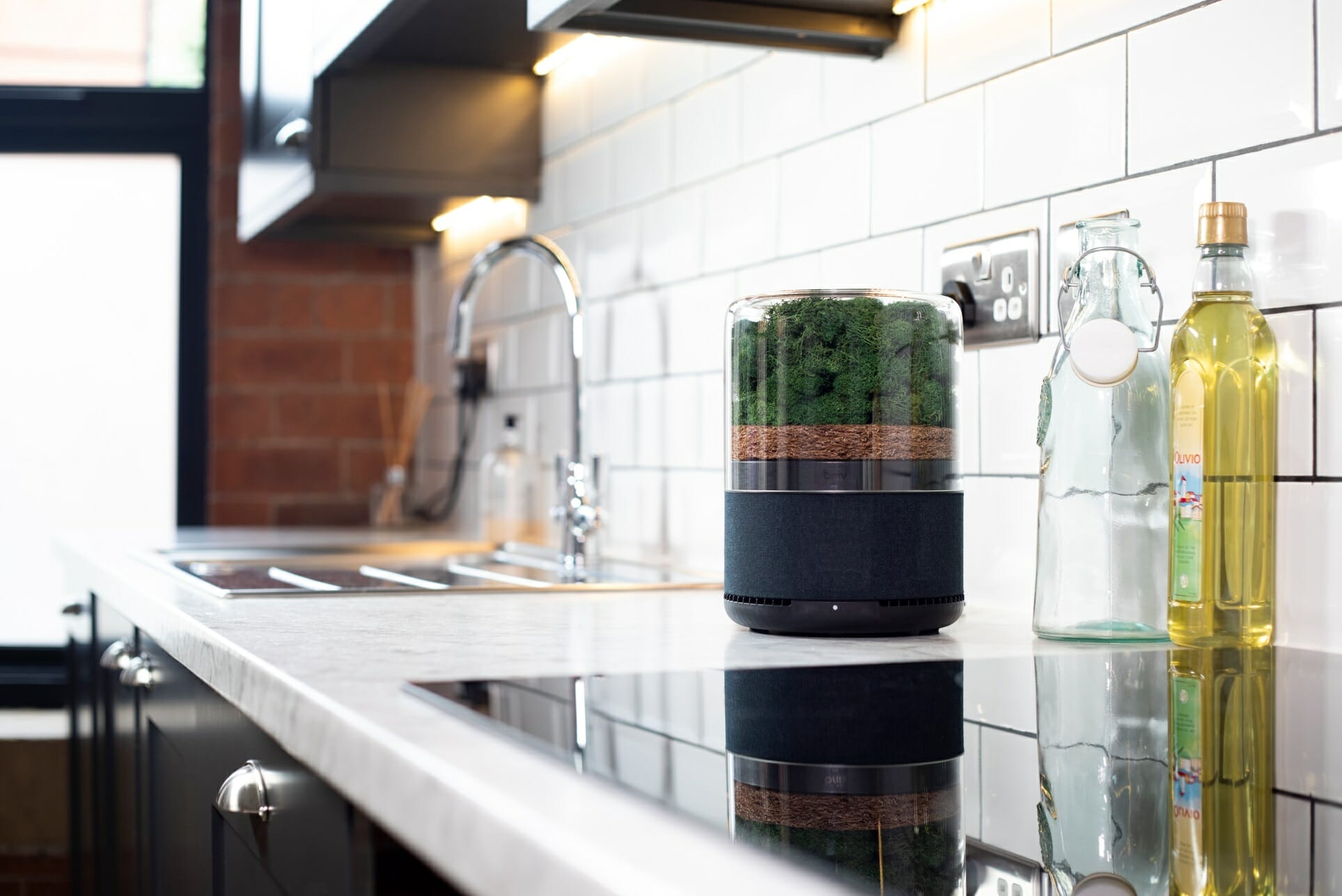
Briiv is a capable, albeit expensive, air purifier unlike anything else on the market. After being successfully kickstarted, this product has come to fruition based on the idea that it is a beautiful, environmentally-friendly, and effective air purifier.
All these points stand true, and I believe many people will be interested in Briiv. It’s a product that has created its own niche and currently stands with almost no competition. The product’s success is a testament to the hard work put into designing something unique.
However, the Briiv air purifier isn’t for everyone. You’ll want to look elsewhere if you’re looking for the most efficient or budget-friendly air purifier. While Briiv can clean the air in small to medium-sized rooms, it isn’t as fast as some cheaper air purifiers. Further, the product’s high price puts it in a price range of very capable air purifiers such as the Airdog air purifiers.
That said, the higher price of Briiv comes with many benefits. You receive a beautiful air purifier that fits well in bedrooms, kitchens, home offices, and even small living rooms. Further, you’re buying into a far more sustainable and eco-friendly device that produces far less waste than most other air purifiers on the market. Perhaps most importantly, you’re purchasing a device that promises to lower costs in the long run due to its energy efficiency.
If these benefits allow you to justify the price, Briiv is an air purifier worth checking out. I noticed the air quality in my bedroom improved markedly when using the device, and my family (particularly my mother), are impressed by how nice the product looks. She’s already asking when she can have it!
Although the Briiv air purifier is already a great product, I would love to see some work put into improving the touch interface, mesh materials, and the app. With these changes, Briiv will have an even better product that will be hard not to recommend.
Briiv FAQ
What Is Briiv?
Briiv is an eco-friendly air purifier designed to purify air through natural means.
Where Can I Buy Briiv?
You can purchase Briiv from the official website.
Is Briiv Effective at Air Purifying?
Through my testing, I found Briiv effective at air purifying a small or medium-sized room.
How Does Briiv Filter?
Briiv filters by forcing particles through a moss pre-filter, a coconut filter, and a silk nano-fibre filter.
Can Briiv Filter VOCs?
Yes! Briiv can filter VOCs.
Can Briiv Filter Particulate Matter?
Yes! Briiv can filter particulate matter including PM1, PM2.5 and PM10.
Have Questions or Comments?
Join the discussion on the BreatheSafeAir Community Forum. Ask any questions you have about air quality or adjacent topics and get quick answers!
Briiv Air Purifier
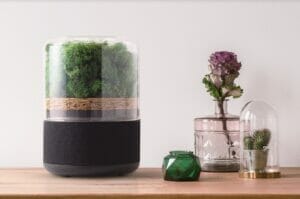
The Briiv air purifier is an air purifier unlike any other. With a focus on environmental friendliness, this air purifier uses low electricity, generates almost no (non-biodegradable) waste, and is crafted from recycled plastics. While relatively small and expensive for an air purifier, it performs well and is worth checking out,
Product Brand: Briiv
3.5
Pros
- Stunning design
- Effective in small to medium-sized rooms
- Eco-friendly
- Small form factor
- Cheap running costs
- Smart integrations
- Easy to use
Cons
- Pricey
- Some parts of the device feel cheap
- App is not great
Impressive review. Thank you.
Brilliant review and such a unique product! I would absolutely love to see you review the IKEA air purifiers and other commonly purchased in store purifiers.
The Briiv does not work it is cheaply made with a high price tag the app is useless.
I purchased this over a year back and about a month after buying it the sensors failed and since this device doesn’t have any physical buttons it rendered to a paperweight. Don’t get me started on the “app” if you have 4 hours to get it to connect every time you use it the functionality it minimal at best. The idea is great the top half of this unit is fantastic the cheap plastic bottom half with the sensors is beyond cheap. I wish the people reviewing this would be honest. A) so customers don’t waste their money and B) so maybe Briiv would improve this design because they have the start of a fantastic product but the final execution has missed the target completely.
Hi,
I’m sorry to hear about your bad experiences with Briiv – based on what you’ve said, I can understand why you are angry with the product! Have you tried reaching out to the team behind Briiv? They may be able to offer some help (hopefully!).
However, suggesting that reviewers like myself aren’t honest is unfair. I’ve had my Briiv for almost six months now, and I have not had any of the issues you’ve experienced. I stated in my article that the bottom part of the device felt cheap, and I wish it were higher quality, but I’ve had no issues with the touchpad on the front of the device. I don’t like the viewing angles of the pad (it’s hard to see the buttons if you are off to the side of the device), but they still work for me after six months of use.
I am also unfamiliar with the issue you are facing regarding the app. I agree the app feels very simple, but I’ve never had issues with it working and connecting – for me, it’s instant! Are you using iOS or Android? Perhaps this is an issue with the Android side, as I only tried the product with an iOS device.
While I understand your frustration, I did my best to be honest in this review. I recommend contacting Briiv and explaining your issues so they are at least aware of this problem.